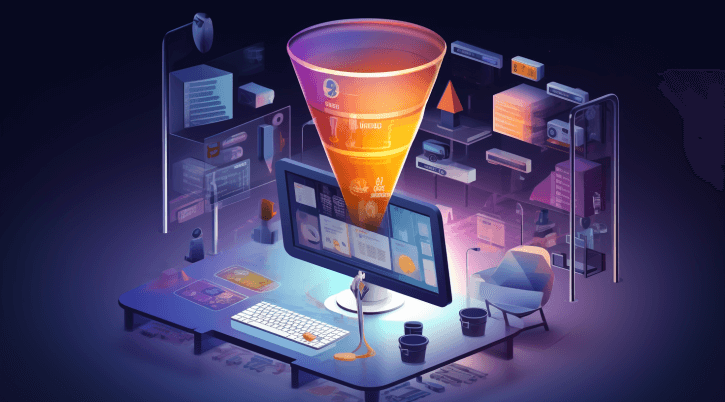The Importance of Lead Generation
In the world of marketing and sales, lead generation plays a critical role in driving revenue and business growth. Lead generation involves identifying and attracting potential customers, known as leads, who have shown interest in a company’s products or services. This process lays the foundation for building relationships, nurturing prospects, and ultimately converting them into loyal customers.
Understanding the Role of Lead Generation
Lead generation serves as the initial step in the customer acquisition journey. By reaching out to a specific target audience, businesses can capture valuable information about potential customers, such as their contact details and preferences. This information allows companies to tailor their marketing efforts and engage with leads in a personalized manner.
A well-executed lead generation strategy enables businesses to fill their sales pipeline with qualified leads who are more likely to convert into paying customers. It helps focus efforts on individuals who have already shown interest in the company’s offerings, increasing the efficiency and effectiveness of the sales process.
Benefits of a High-Performing Lead Generation Funnel
A high-performing lead generation funnel offers numerous benefits to businesses across various industries. Let’s explore some of the key advantages:
- Increased Sales and Revenue: A successful lead generation funnel allows businesses to consistently attract and convert leads into customers. By nurturing leads through targeted marketing efforts, companies can increase their sales and revenue streams.
- Improved Customer Targeting: With a well-defined lead generation strategy, businesses can identify their ideal customer profile and create buyer personas. This enables them to target their marketing efforts towards individuals who are more likely to have a genuine interest in their products or services.
- Enhanced Return on Investment (ROI): By focusing on lead generation, companies can optimize their marketing budget and resources. By investing in strategies that attract qualified leads, businesses can maximize their return on investment and improve overall marketing efficiency.
- Building Customer Relationships: Effective lead generation is not only about acquiring new customers but also about building long-term relationships. By providing valuable content and personalized interactions, businesses can establish trust and credibility with their leads, fostering customer loyalty.
To create and maintain a high-performing lead generation funnel, it is crucial to focus on the building blocks of lead generation, such as attracting the right audience, capturing leads, and nurturing them through effective email marketing. By implementing proven lead generation strategies, businesses can drive growth and achieve their sales objectives.
Building Blocks of a Lead Generation Funnel
To create an effective lead generation funnel, you need to focus on three essential building blocks: attracting the right audience, capturing leads and building a database, and nurturing leads through email marketing.
Attracting the Right Audience
Attracting the right audience is the first step in the lead generation process. To do this successfully, it’s crucial to define your target audience and buyer persona. Understanding who your ideal customers are helps you tailor your marketing efforts and messaging to resonate with them.
To attract the right audience, you can employ various strategies such as content marketing and SEO. By creating valuable and informative content that addresses the pain points and interests of your target audience, you can attract organic traffic to your website. Optimizing your content for search engines helps increase visibility and drive relevant traffic. For more information on attracting the right audience, check out our article on b2b lead generation.
Capturing Leads and Building a Database
Once you have attracted the right audience, the next step is to capture their information and build a database of leads. This is typically done through lead generation forms on your website or landing pages. These forms should be optimized to collect the necessary information while being user-friendly and engaging.
When designing your lead generation forms, keep in mind that asking for too much information upfront may deter potential leads from completing the form. Start with capturing the essential details, such as name and email address, and gradually gather more information as you nurture the leads. It’s also important to assure your audience that their information will be handled securely and in accordance with privacy regulations.
To streamline the process of capturing and managing leads, consider using lead generation software or automation tools. These tools can help you organize and track your leads effectively, ensuring a smooth transition from lead capture to nurturing. For more information on lead generation tools and software, visit our article on lead generation tools.
Nurturing Leads through Email Marketing
Once you have captured leads and built a database, it’s time to nurture those leads and guide them through the buyer’s journey. Email marketing is a powerful tool for lead nurturing, allowing you to stay connected with your leads and provide them with valuable content and offers.
Crafting engaging and personalized email campaigns is key to nurturing leads effectively. Segment your leads based on their interests, behavior, or stage in the buyer’s journey to deliver targeted and relevant content. This helps build trust and credibility, increasing the chances of converting leads into customers.
Consider utilizing cold email outreach as part of your lead nurturing strategy. Craft compelling and personalized emails to initiate conversations with potential leads who have not yet interacted with your brand. For tips on writing effective cold emails and subject lines, check out our articles on cold email templates and cold email subject lines.
By focusing on attracting the right audience, capturing leads effectively, and nurturing them through email marketing, you can build a high-performing lead generation funnel. Remember to track and analyze key metrics, conduct A/B testing, and continuously iterate on your strategies to optimize your lead generation efforts.
Crafting an Effective Lead Generation Funnel
To create a high-performing lead generation funnel, it’s important to focus on three key components: defining your target audience and buyer persona, creating engaging lead magnets, and designing high-converting landing pages.
Defining Your Target Audience and Buyer Persona
Before diving into lead generation tactics, it’s crucial to have a clear understanding of your target audience and buyer persona. By defining these profiles, you can tailor your lead generation efforts to attract the right prospects.
Start by conducting market research to identify the characteristics and preferences of your ideal customers. Consider factors such as demographics, interests, pain points, and buying behaviors. This information will help you create targeted messaging and offers that resonate with your audience.
Once you have a clear understanding of your target audience, develop buyer personas that represent different segments within your target market. These personas should include detailed information about their motivations, goals, challenges, and objections. Understanding your audience and buyer personas will allow you to craft personalized content and offers that drive engagement and conversions.
Creating Engaging Lead Magnets
Lead magnets are valuable resources or incentives that you offer to prospects in exchange for their contact information. These can include ebooks, whitepapers, webinars, templates, checklists, or any other content that provides relevant and useful information to your target audience.
When creating lead magnets, focus on addressing the pain points or challenges your audience faces. Offer solutions or insights that will position you as an expert in your industry. Make sure your lead magnets are visually appealing and easily accessible.
To optimize the effectiveness of your lead magnets, include a strong call-to-action that prompts visitors to provide their contact details. This can be done through a lead capture form on a dedicated landing page or as a part of a pop-up on your website.
Designing High-Converting Landing Pages
Landing pages play a critical role in converting website visitors into leads. When designing your landing pages, keep the following best practices in mind:
- Keep the design clean and uncluttered, with a focus on the main offer and call-to-action.
- Craft compelling headlines that clearly communicate the value of your offer.
- Use persuasive copy that highlights the benefits and addresses the pain points of your target audience.
- Include visually appealing images or videos that support the message and engage visitors.
- Keep the form fields simple and only ask for necessary information to minimize friction.
- Add social proof elements, such as testimonials or case studies, to build trust and credibility.
- Optimize your landing pages for mobile devices to ensure a seamless experience for all users.
By following these best practices, you can create landing pages that capture and convert leads effectively. Regularly test and optimize your landing pages to improve their performance and increase your conversion rates.
Crafting an effective lead generation funnel is a continuous process that requires constant evaluation and refinement. To learn more about optimizing and analyzing your lead generation funnel, refer to our article on tracking and analyzing key metrics, A/B testing and conversion rate optimization, and continuous improvement and iteration.
Implementing Lead Generation Strategies
To drive successful lead generation, businesses employ various strategies to reach and engage their target audience. Three effective lead generation strategies are cold email outreach, content marketing and SEO, and social media advertising.
Cold Email Outreach
Cold email outreach is a proactive approach to reaching potential leads. It involves sending personalized emails to individuals who have not previously engaged with your business. The goal is to capture their interest and guide them through the lead generation funnel.
When implementing cold email outreach, it’s important to craft compelling subject lines and email templates that grab the recipient’s attention. Personalization and relevance are key. By addressing pain points or offering valuable insights, you can increase the chances of a positive response. For inspiration, check out our article on cold email templates.
To improve the effectiveness of your cold email outreach, leverage automation tools and software that help manage and track your email campaigns. These tools can streamline the process, allowing you to send personalized emails at scale while tracking open rates, click-through rates, and other key metrics. For a list of useful tools, refer to our article on cold email software.
Content Marketing and SEO
Content marketing and search engine optimization (SEO) play a crucial role in attracting and engaging potential leads. By creating informative and valuable content, businesses can position themselves as industry experts and build trust with their audience.
To leverage content marketing and SEO for lead generation, develop a content strategy that addresses the pain points and interests of your target audience. This can include blog posts, articles, videos, podcasts, and infographics. By optimizing your content with relevant keywords and providing solutions to common problems, you can increase organic traffic to your website. For more insights, visit our article on content marketing and SEO.
To further enhance your content marketing efforts, consider incorporating lead magnets into your content. Lead magnets are valuable resources, such as ebooks, whitepapers, or webinars, that are offered in exchange for the visitor’s contact information. This allows you to capture leads and nurture them through the lead generation funnel. For tips on creating engaging lead magnets, refer to our article on lead generation ideas.
Social Media Advertising
Social media platforms provide an effective channel for targeting and engaging potential leads. Through social media advertising, businesses can reach their desired audience based on demographics, interests, and behaviors.
To implement social media advertising for lead generation, start by defining your target audience and selecting the appropriate social media platforms where they are most active. Craft compelling ad copy and creative elements that capture attention and drive users to take action. By including a strong call-to-action and directing users to a high-converting landing page, you can increase the chances of converting them into leads.
It’s important to continuously monitor and optimize your social media ad campaigns. Analyze key metrics such as click-through rates, conversion rates, and cost per lead to identify areas for improvement. By refining your targeting, messaging, and creative elements, you can maximize the effectiveness of your social media advertising efforts.
By implementing these lead generation strategies – cold email outreach, content marketing and SEO, and social media advertising – businesses can effectively attract and engage potential leads, guiding them through the lead generation funnel. Remember to regularly analyze and optimize your strategies to ensure continuous improvement and drive revenue growth.
Optimizing and Analyzing Your Lead Generation Funnel
Once you have built your lead generation funnel, the work doesn’t stop there. To ensure its effectiveness and drive better results, it’s essential to optimize and analyze your lead generation funnel continuously. By tracking key metrics, conducting A/B tests, and focusing on continuous improvement, you can enhance the performance of your lead generation efforts.
Tracking and Analyzing Key Metrics
Tracking and analyzing key metrics is vital to understanding the effectiveness of your lead generation funnel. By monitoring these metrics, you can identify areas of improvement and make data-driven decisions to optimize your funnel. Here are some essential metrics to track:
| Metric | Description |
|---|---|
| Conversion Rate | The percentage of leads that convert into customers. |
| Cost per Lead | The average cost incurred for generating a single lead. |
| Lead Quality | The quality of leads generated, indicating their potential to convert into paying customers. |
| Return on Investment | The financial return on your lead generation efforts, calculated by comparing the revenue generated to the cost incurred. |
| Lead Velocity | The speed at which leads move through your funnel, indicating the efficiency of your nurturing and conversion processes. |
By regularly analyzing these metrics, you can identify bottlenecks, areas of improvement, and potential opportunities for optimizing your lead generation funnel.
A/B Testing and Conversion Rate Optimization
A/B testing is a powerful technique to optimize your lead generation funnel. By testing different variations of your landing pages, lead magnets, email subject lines, or call-to-action buttons, you can determine which elements perform better in terms of conversion rates. Some elements you can A/B test include:
- Headlines and subheadings
- Content length and formatting
- Imagery and visuals
- Color schemes and button designs
- Call-to-action placement and wording
Through A/B testing, you can uncover insights about what resonates best with your target audience and refine your lead generation funnel accordingly. Remember to test one element at a time to accurately measure the impact of each change.
Continuous Improvement and Iteration
The process of optimizing your lead generation funnel is iterative. It requires a commitment to continuous improvement based on data-driven insights and feedback. Regularly reviewing your metrics, analyzing A/B test results, and gathering customer feedback can help you identify areas that need improvement or adjustment.
Consider implementing a feedback loop to gather insights from your sales team or directly from customers. This feedback can provide valuable information on the quality of leads generated, the effectiveness of your nurturing process, and potential pain points or areas for improvement.
Remember, optimization is an ongoing process. As you gather more data and insights, be prepared to make adjustments and iterate on your lead generation funnel to achieve better results.
By focusing on tracking key metrics, conducting A/B tests, and continuously improving your lead generation funnel, you can drive better performance and increase the effectiveness of your lead generation efforts. Keep in mind that optimization is not a one-time task but rather an ongoing practice that requires attention and adaptation to meet the changing needs of your target audience and market.



